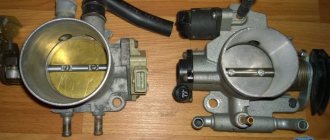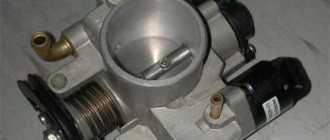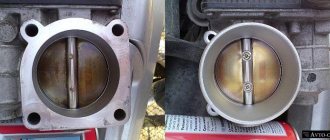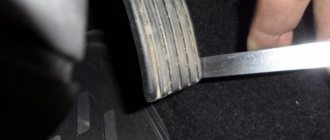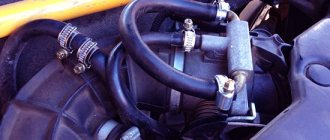Cleaning the Lada Kalina throttle assembly begins with its dismantling.
Note. There is an opinion that it is not necessary to remove the component. This is true, but in this case all the carbon deposits will pour into the engine!
First of all, you need to turn off the engine, let it cool, and then remove the terminal from the battery.
Then the clamps securing the hoses and pipes are unscrewed:
- Small – 4 units;
- Large – 1 unit.
The plugs are disconnected from two sensors - TPS and IAC.
The accelerator cable is removed.
To prevent antifreeze from leaking, the hoses must be fixed at the top. In addition, you can insert M12 bolts into them.
In the end, all that remains is to unscrew the 2 nuts using a 13mm socket and remove the remote control.
List of necessary tools for removing the assembly
- Flathead and Phillips screwdrivers
- Head for 13
- Extension cord short
- Ratchet or crank
- Pliers (in some cases)
Before starting repairs, disconnect the battery by removing the negative terminal, since you will then have to disconnect the sensor plugs, and the turned on power will be of no use.
Mistakes when cleaning the throttle valve
Many inexperienced car owners can incorrectly clean the throttle assembly, at a minimum risking not getting the desired effect, and at maximum - completely damaging and disabling the throttle body. Therefore, it is important to understand when to do the procedure, how to do it and what means to use.
Dirty throttle valve
Clean throttle
To properly clean the throttle body DO NOT :
- Clean the damper in any unclear situation (there are even jokes about this).
- Clean the damper without removing it (the effectiveness of such cleaning is insignificant, since often it is only possible to remove carbon deposits on the damper itself, and the internal walls and air channels of the damper are not cleaned).
- When cleaning with a rag, use excessive force, which can lead to damage to both the damper itself and the nearby TPS.
- Use brushes rather than soft materials. Such an error also quite often leads to loss of performance of the remote control, since on some throttle units the inner wall and damper are coated with molybdenum for even smoother air passage. This layer is often confused with plaque and is removed. As a result, the damper begins to either “bite” or allow excess air to pass through (the speed increases).
- Forgetting to teach the throttle after cleaning. Dampers with an electronic gas pedal require proper learning of the remote control in order to set the idle speed to the required value.
The throttle valve should be cleaned every 30-50 thousand km . Adhering to all the above recommendations and taking into account the main mistakes that inexperienced car owners make, no more questions should arise about how to clean the throttle valve, be it mechanical or electronic. For cleaning you need a minimum of equipment and costs, just a carb cleaner and clean rags, as well as a screwdriver for dismantling the unit.
Replacement of intake manifold gaskets VAZ 2114 8 cl (Kalina, 2110)
It is recommended to replace the gaskets on the VAZ intake manifold after each removal. But I had to do this prematurely, as I discovered a significant air leak, which mainly manifested itself on a cold engine. Every cold start was accompanied by a terrible tripping.
In addition to the tripping when cold, there was a slight drop in speed when sharply pressing the gas pedal. This applies to both a cold and a hot engine.
A homemade smoke generator made from a cigarette helped me detect the air leak. A very simple and primitive contraption that has helped me out more than once.
My car (Kalina 1.6 8 valves) has a plastic intake manifold (receiver). The same will be installed on all VAZ family cars with an 8-valve 1.6-liter engine (2114, 2110, etc.). 4 rubber rings act as gaskets. According to reviews, black rings last much longer than white ones. And I was convinced of this personally - these gaskets lasted for about six months and began to let air through. They felt like plastic to the touch. Unfortunately, I didn’t find black ones, so I’ll install white ones again. I hope these last longer.
To remove the intake manifold (receiver), you must first unscrew the corrugation from the air filter, the throttle cable, and the small crankcase ventilation hoses. I will not remove the throttle and its heating.
The intake manifold is attached to 5 studs - one in the center, two on the sides. To unscrew them you will need a 13mm socket. After unscrewing the nuts, you need to remove the receiver itself from the studs and move it to the side. Remove the old gaskets and wipe the seats from oil and dirt. You also need to wipe the seat on the engine.
The manifold has special grooves for guides on the gaskets. The gaskets must be installed with the higher side in the plastic manifold. It is the guide that will prevent you from making mistakes.
I additionally coated the areas near the guides with sealant on the outside of the gasket. Because it felt like that was where the ring entered the groove the deepest. In addition, there was a place for air leaks on the old gaskets.
After all procedures, the intake manifold can be installed back. I couldn't find any information on how tightly to tighten the mounting nuts. I delayed it at my own peril and risk. The main thing is not to overtighten, as the manifold is plastic and can crack.
This is how I replaced the old intake manifold gaskets on my Kalina with new ones. There is no more air leakage, the engine stopped stalling when cold and began to behave much better when warm.
Source
Repair and service
Cleaning the throttle valve is a simple operation that can be performed by any car enthusiast. Today we will share a photo report on how to clean the throttle valve yourself.
The main symptoms of a dirty throttle valve are:
- Floating idle
- Difficulty starting the engine
- Car jerking when driving at minimum speeds
The damper is contaminated by carbon deposits and oil vapor from the crankcase ventilation system, so it is advisable to clean it every 40-50 thousand km.
To clean the throttle body, it must be removed from the vehicle. For cars with an electronic gas pedal (E-gas), this is easier to do, since there is no need to disconnect the gas cable, heating hoses, or sensors.
Adaptation using the example of some cars
Another method, which we will consider using the example of one well-known German brand, also involves adaptation without a computer. Here you should warm up the engine to a temperature of approximately 70-99°C. The battery voltage must be at least 12.9 Volts when the engine is not running. The action plan for how to adapt the throttle valve on a Volkswagen will be something like this:
- After warming up and turning off the engine, you should wait a short period (5-10 seconds).
- With the gas pedal released, turn on the ignition and wait 3 seconds.
- After 3 seconds, you need to press the accelerator pedal all the way 5 times and release it back. Act quickly, as you only have 5 seconds to do this.
- After the 5th exercise, you should wait a pause.
- After 7 seconds, press the pedal all the way again and hold it in this position until the “CHEK” indicator starts flashing (≈ 10 sec.), then it should remain on continuously (≈ 20 sec.).
- When the indicator lights up constantly, count to three and only then release the pedal.
- Start the engine (repeat if necessary), wait 20 seconds, then lightly accelerate (2000-3500). If the tachometer shows 700 rpm at XX (+- 50), it means that the adaptation was successful.
In this case, it is necessary to strictly adhere to the time intervals of each setting step. This is the only way the ECU training will go smoothly. But before that, it’s worth studying the adaptation features and the possibility of a manual procedure for your car. Perhaps only service station specialists can help.
The importance of the throttle valve adaptation procedure can hardly be underestimated, and not every car enthusiast knows how to perform this operation on their own.
How to clean the throttle body (general principles)
There are two cleaning options: without removing the unit and after dismantling. In the first case, the effectiveness of soot removal will be minimal. Cleaning without removal is carried out only in extreme cases, since carbon deposits are removed only from the damper, and deposits remain on the walls and air channels.
Complete cleaning gives a more noticeable effect. Work begins with removing the unit, which is located between the intake manifold and the air filter.
On cars from different manufacturers, the work may differ, but not significantly. On most vehicles this happens as follows:
- The corrugation connects the damper with the air purification filter: it must be removed first;
- Next, turn off the throttle position and absolute pressure sensor (if available and installed on the car);
- Then you need to squeeze out the weight that secures the accelerator pedal cable
- dismantle (disconnect) the coolant pipes. At this stage, work must be carried out very carefully. If the power unit has not completely cooled down, hot drops of technical fluid can cause a burn if they come into contact with human skin, remember this;
- Disconnect the crankcase gas and absorber ventilation hoses;
- Then you need to unscrew the fastenings of the throttle assembly and dismantle it.
- Having removed the mechanism, we unscrew the idle speed regulator. Washing and cleaning it is highly advisable. To rinse the entire assembly, you must use special products.
Do not forget! Before washing the unit using chemicals, be sure to remove all rubber elements to prevent them from becoming deformed.
Washing the throttle valve is possible using budget detergents ("Karbakliner") and more effective, but expensive ones.
Frequent injection system malfunctions
Pay attention to the ignition module. It is quite possible that the malfunction lies there. But the module can only be checked using modern motor testers. Therefore, you need to contact an experienced auto electrician who will quickly identify the fault and replace or repair the module. If it is possible to install and test a working element, take advantage of it. The engine started working perfectly - run to the store for a new module. Repairing this unit is possible, but finding a professional technician is quite difficult.
A malfunction of the idle speed control can be determined by the following symptom: it is impossible to start the engine without pressing the gas. The sensor is located next to the TPS, directly on the pipe. But you shouldn’t change it right away; try rinsing and cleaning it first. Very often the regulator simply becomes dirty, so it feels like it has failed. The price of such items has now dropped, and the choice of them in stores is very large.
Symptoms of a dirty throttle body
- The speed is XX;
- Unstable operation of the internal combustion engine (vibration);
- Dips when moving;
- The engine does not develop power;
- Difficulty starting;
- Increased speed XX;
All of these symptoms may indicate contamination of the throttle assembly, and if these problems are detected in your car, the first thing you need to do is clean the throttle assembly.
Cleaning algorithm
Now we will give a step-by-step algorithm for properly cleaning the throttle valve.
- First of all, you need to get to the damper itself. The design is different in different engines. But as a rule, to do this you need to remove the air duct that runs from the damper to the air filter.
- Dismantle the damper. To do this, unscrew several mounting bolts (2-4 pieces), and also disconnect the necessary connectors (for example, the connector from the absorber purge valve).
- To clean, you must use a carburetor cleaner. There is a wide variety of them, and in auto stores you can easily find a product in accordance with your preferences and capabilities (we will talk about them later).
- Using a rag and the mentioned product, you must thoroughly wipe the damper outside and inside.
- You also need to clean the protective grille (if your car has one).
- Assembly of the unit is carried out in the reverse order.
An easy way to clean your throttle body
The correct way to clean the throttle body
Operating principle of the sensor
The Kalina throttle sensor is used to transmit a signal to the engine ECU. This part is a potentiometer, the maximum output voltage of which does not exceed 5 Volts. The element consists of a housing, inside of which there is a variable resistor. The positive power wire is connected to one of the contacts of the product, and ground to the second. An output conductor is connected to the third terminal, the voltage of which depends on the angle of the throttle valve. The potential difference is changed by moving the moving part of the third contact along resistive tracks.
The moving contact of the potentiometer is installed on the throttle valve axis, so a change in the position of this element is instantly responded by a change in voltage at the output contact.


